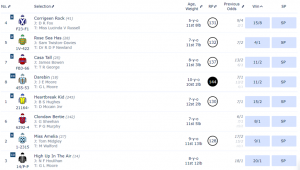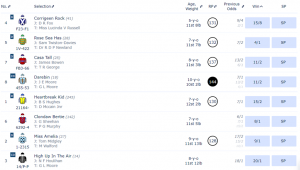
Reading the form on a racecard is the very best way to make an informed decision on which horse you think may win the race or get placed.
Read left to right, the form listings are easy enough to understand when you know what each character signifies.
In simple terms, the numbers tell us where in the race the horse finished, and dashes indicate notable period of time off the racetrack, where the horse may have been out of work. For example, form listed as 312-4 tells us that the horse came third, then first, then second prior to a break, after which it finished fourth on its latest outing.
But what if the form reads 3P2-4, or 3U2-4? And is the horse any better or worse for having these letters in its form? There are numerous abbreviations of industry terms which denote non-finishers and their reason for not completing the race.
Read on for a brief guide on the meanings of the most common abbreviations to help you make your selections next time you read a racecard.

Horse racing betting odds at William Hill
[Pulled-Up] – [PU/P]
PU or P means ‘Pulled-Up’. In these instances, the jockey has made the decision mid-race to stop their horse from finishing. They do this for the best interests of the horse, who may be struggling with the ground, feeling lame, or may have made a bad mistake at an obstacle. Pulling-up is a way to save the horse for another day, not risking any injuries by forgoing the race and a better result. Even the very best horses are pulled up from time to time, so this is usually no reflection on ability.
[Unseated] – [UR/U]
UR or U means that a horse unseated its rider during the race. In these instances, the jockey falls off as a result of a horse jumping a fence badly, misbehaving or stumbling. Horses often continue to gallop with the field in these circumstances, but, as they are not carrying a rider, are no longer included in the results, even if they go past the winning post. Again, this is usually just bad luck and is no reflection on the ability of the horse or the jockey.
[Void Race] – [V]
Unforeseen, extraordinary circumstances can, on rare occasions, require a race to be voided, therefore yielding no result. This is presented in a horse’s form as ‘V’.
[Refused] – [R]
An ‘R’ in the form means either ‘refused’ or ‘ran-out’. These are two slightly differing terms for an instance where a horse declines to jump a fence during the race. Coming to a stop when presented at the fence is known as ‘refusing’, whereas ducking out to the side of a fence is known as ‘running out’. The result of both is the same: elimination from the race as all fences must be cleared in order to officially complete the race. A horse who refuses often is seen as unreliable, and you may want to think twice before betting on a horse with an ‘R’ next to their name.
[Outside first 10] – [0]
While this does not denote a non-finisher, it is worth knowing that a 0 in a horse’s form indicates an occasion where the horse finished the race but was not in the first ten over the line. This does not always mean that the horse is no good; even the best horses can struggle in the wrong conditions, so it is seldom advised to take form at face value.
Horse racing betting odds at William Hill
The post Horse Racing Terms and Abbreviations appeared first on William Hill News.
